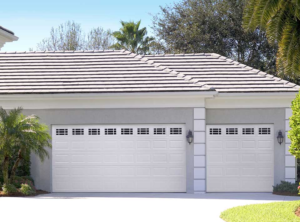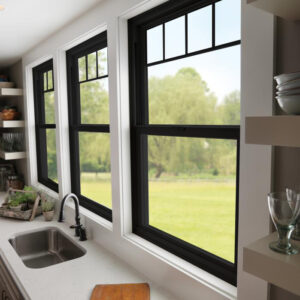Investing in the right garage door can add value to your home. It can also help protect your valuable possessions and keep intruders out.
Consider your local climate and maintenance preferences when choosing a model to get the most out of your garage door. The R-value, bottom fixtures, and panel designs are a few key points to remember. Click https://patriotgaragedoorok.com/ to learn more.

The garage door is an everyday feature, but have you ever wondered where it came from? Like many things we take for granted, it has a long and complicated history. Today, it is one of the most common features in any home and a symbol of wealth.
Before the invention of the garage door, people stored their cars in sheds or barn-like structures with doors that hung from hinges and swung outward. This was inconvenient for drivers and impractical in snow. As car production took off in the early 1910s, these old-fashioned structures were no longer suitable for storing vehicles. In addition, public garages became crowded and expensive, forcing people to look for alternative methods of car storage.
At that time, garage doors were mostly constructed of solid wood with single panels that hung from hinges and opened outward, much like barn doors. These large doors required significant space in front of the garage, making them unsuitable for smaller homes or narrow driveways. By 1921, an inventor named C.G. Johnson invented the overhead garage door. Five years later, he also invented the electric garage door opener.
The garage door as we know it was a revolutionary invention. These new doors could be operated by a remote control that allowed drivers to open or close the door without having to get out of their vehicle. However, the system was still a bit clunky and required that drivers position their vehicle at least a few feet away from the garage.
In the 1920s, garage doors began to be constructed of sections that folded up into each other and were positioned on tracks parallel to the ceiling. This improved garage efficiency and made it possible to store more vehicles in the same size of garage.
It is interesting to note that a few of the most famous corporations in the world have humble beginnings in someone’s garage. Some of these brands include Harley Davidson, Disney, Apple, Mattel, and Amazon. They have grown into massive conglomerates that earn billions of dollars in revenue. The garage is also known for being the starting point of many popular bands. Some of the most successful acts in history including the Beatles, the Rolling Stones, and Aerosmith started by rehearsing in a garage.
Design
The garage door’s design is a key element in its appearance and functionality. The wide variety of available options, including materials, shapes and sizes, allow homeowners to customize their doors to suit their aesthetic preferences and architectural style.
While roller and sectional doors may require a greater upfront investment, their versatility can deliver a harmonious balance between functionality and visual appeal. Moreover, the wide range of available materials compatible with sectional doors can help homeowners maximize energy efficiency and potentially enjoy long-term savings on utility bills.
Fiberglass garage doors used to be popular but declined in popularity once steel and aluminum came into use. However, fiberglass doors are now reemerging in the market with an updated look. They are able to mimic the color and texture of traditional wood doors, but have several other benefits such as durability, resistance to salt corrosion and lower maintenance expenses.
Steel residential garage doors are durable and offer a high level of security. Raynor’s Aspen Series steel door offers the ultimate in safety and quality, combining a three-layer construction with the company’s proprietary WeatherLock® section joint seal to prevent cold air infiltration and heat loss. In addition, the AP200LV LuxeVue combines all of the aesthetic design options of the Aspen Series line with a dramatically oversized top window section that can let in 20% more natural light.
The bottom fixture or bracket, consists of one or two tightly wound steel springs on a central bearing plate and steel cable drums at both ends. The steel counterbalance cables run from these brackets to the end bearing plates where they are hooked into a notch on each of the cable drums. When the door is pulled up, the stored tension in the springs unwind, causing the cables to wrap around the rim of each cable drum.
These systems provide a level of performance and longevity that exceeds the life of conventional extension springs. However, their operation is noisier than other counterbalance systems. Also, their cycle life is limited by the number of times the door is opened and closed.
Security
The garage door is often overlooked as a point of entry into the home, but burglars know that it’s often full of valuable items they can sell. The good news is that there are plenty of security measures you can take to prevent thieves from entering your home through the garage.
One of the first things to do is beef up the garage door’s lock. Many of the older roller garage doors only have a small latch on the inside that can easily be forced open by a determined thief. The best solution is to fit a steel or uPVC personnel door with multi locking points and an alarm.
Ensure your garage door has a keypad that requires a code to be activated. This will stop any intruders from using a universal remote code grabber to copy your garage door’s signal and open the door from the outside. You can also purchase smart phone controlled door locks which can be opened and closed from your smartphone or linked into a home security system.
If you have garage windows, consider covering them so that crooks can’t peer in and see all your tools and valuables. Sheer curtains or translucent window film lets in light but can keep your belongings out of sight. Consider adding a security camera to your garage or linking it into your home security system. Motion sensors will alert you to any activity around your garage and can help deter criminals.
Make sure that you keep your garage door maintained on a regular basis. This will ensure that any bolts or hinges aren’t rusted and weakening the garage door’s protection.
Finally, don’t forget to secure the service door and the door from your garage into the house. Make sure both have a deadbolt and a heavy-duty strike plate.
It’s also a good idea to have a peephole installed on the side of your garage door to see who is knocking at your door before you answer it. You can also invest in a “noisy” doorbell which makes a loud noise when someone is nearby.
Energy Efficiency
A non-insulated or minimally insulated garage door allows heat to escape during the winter and cool air to enter in the summer, causing HVAC systems to work harder to maintain a comfortable temperature in living areas. Upgrading to an insulated garage door helps lower energy costs, reduces greenhouse gas emissions and provides peace of mind for homeowners.
While steel is not a natural insulator, a high-quality steel door can be layered with polyurethane insulation to improve its energy efficiency. The Clopay(r) Intellicore(r) garage door line, for example, offers two steel layers with your choice of polyurethane or polystyrene insulation between them. Additionally, a WINDCODE(r) reinforcement option is available to provide added protection against strong winds.
Insulated garage doors also help dampen noise pollution from outside, creating a quieter and more peaceful interior environment. This benefit is especially important for households near noisy neighborhoods or busy streets. Finally, a garage door with insulation is heavier than a non-insulated model, so it doesn’t rattle when opening or closing as easily.
In addition to lowering your energy bills and improving comfort, an insulated garage door may also increase the value of your home. Prospective buyers are increasingly seeking energy-efficient features that will cut long-term utility costs and provide environmental benefits. Providing a new, energy-efficient garage door is one easy way to meet these demands.
The insulating properties of garage doors are measured with R-values, which indicate how much thermal energy they retain or transfer. The higher the R-value, the more insulated the garage door is. A typical residential garage door with insulation has an R-value of between 15 and 17.
If you’re on a budget, consider upgrading to an insulated steel or aluminum garage door that contains polystyrene insulation, which is less expensive than polyurethane foam. These types of garage doors are still highly durable and provide a good level of energy efficiency.
Other quick, DIY changes that can make your garage more energy efficient include adding weather stripping around the outer edges of the door frame and sealing any cracks or gaps where air can seep in or out. Also, replacing conventional light bulbs with LED or energy-saving ones will decrease electricity consumption and reduce your energy bills.


